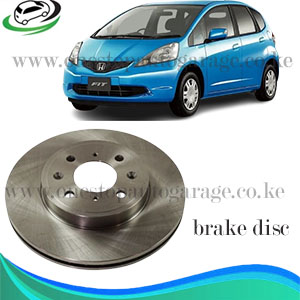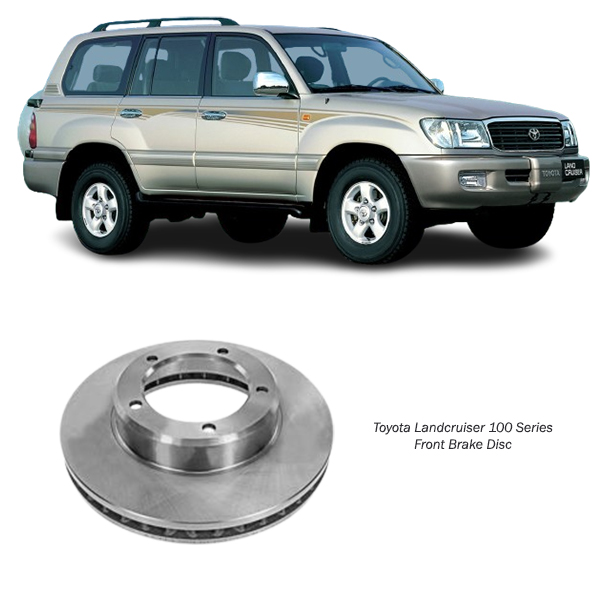-14%
Get Toyota Land Cruiser 100 Series Front Brake Disc 43512-60170 in Kenya
The front brake disc, also known as the brake rotor, is a pivotal component of your vehicle’s braking system. As part of a disc brake system, it plays an integral role in ensuring safe and efficient braking by converting kinetic energy into heat through friction. This guide delves deep into the construction, function, benefits, maintenance, and replacement of front brake discs, offering a thorough understanding of their importance in automotive performance and safety.
What Is a Front Brake Disc?
A front brake disc is a round metal component attached to the wheel hub of a vehicle. When the brake pedal is pressed, the brake pads clamp down on the spinning disc, creating friction that slows and eventually stops the wheel’s rotation.
Brake discs are typically made from durable materials such as cast iron or carbon composites to withstand the high temperatures and pressures they encounter during braking.
Functions of a Front Brake Disc
- Slowing Down the Vehicle:
- The primary role of the brake disc is to convert the vehicle’s kinetic energy into heat through friction, allowing the vehicle to slow down or come to a complete stop.
- Heat Dissipation:
- Brake discs are designed to dissipate heat quickly to prevent overheating and maintain consistent braking performance.
- Stability and Control:
- By enabling precise braking, the disc helps maintain vehicle stability and control, particularly during sudden stops or in adverse conditions.
- Enhanced Braking Efficiency:
- Paired with brake pads, discs ensure effective and responsive braking.
Types of Front Brake Discs
- Solid Discs:
- These are flat, solid rotors with no internal venting. They are commonly used in smaller vehicles and are cost-effective but less efficient in heat dissipation.
- Vented Discs:
- Feature internal vanes that allow air to flow through, enhancing cooling and reducing the risk of brake fade. Ideal for heavier vehicles or those requiring high-performance braking.
- Drilled Discs:
- Have holes drilled through them to improve heat dissipation and reduce weight. They are commonly used in performance or sports cars.
- Slotted Discs:
- Feature grooves on the surface to remove debris and gases generated during braking, improving performance and reducing fade.
- Composite Discs:
- Made from advanced materials such as carbon-ceramic, these discs offer superior heat resistance and durability but are expensive.
Construction of Front Brake Discs
A typical brake disc comprises the following elements:
- Disc Surface:
- The main contact area where the brake pads clamp down. This surface must remain smooth and free from grooves or warping.
- Ventilation Vanes:
- Found in vented discs, these channels improve airflow to cool the disc during operation.
- Mounting Hub:
- The center section of the disc that attaches to the wheel hub, ensuring alignment and stability.
- Protective Coatings:
- Many discs come with anti-corrosion coatings to extend their lifespan, particularly in harsh environments.
Signs of Worn or Damaged Front Brake Discs
- Vibrations When Braking:
- Warped discs can cause the steering wheel to vibrate during braking.
- Squealing or Grinding Noises:
- These sounds often indicate excessive wear or the presence of grooves on the disc surface.
- Increased Stopping Distance:
- Reduced braking efficiency is a sign of worn discs that can no longer provide adequate friction.
- Visible Damage:
- Grooves, cracks, or discoloration on the disc surface are indicators of wear or overheating.
- Brake Warning Light:
- Some vehicles have sensors that alert you to issues with the brake system, including the discs.
Causes of Front Brake Disc Issues
- Overheating:
- Excessive heat during braking can cause warping or cracking.
- Excessive Wear:
- Continuous use over time naturally reduces the disc’s thickness.
- Contamination:
- Dirt, oil, or debris on the disc surface can impair braking performance.
- Improper Installation:
- Misalignment or incorrect torque during installation can lead to uneven wear.
- Aggressive Driving:
- Hard braking or frequent high-speed stops can accelerate wear and overheating.
Maintaining Front Brake Discs
- Regular Inspections:
- Periodically check the discs for signs of wear, such as grooves, cracks, or warping.
- Replace Brake Pads Timely:
- Worn brake pads can damage the disc surface. Replace them before they become excessively thin.
- Keep Discs Clean:
- Ensure the discs are free from contaminants like oil or dirt.
- Avoid Overloading:
- Excessive weight puts extra stress on the braking system, accelerating disc wear.
- Drive Responsibly:
- Avoid harsh braking unless necessary, and use engine braking to reduce reliance on the brakes.
Replacing Front Brake Discs
When to Replace:
- Replace brake discs when they reach the manufacturer’s minimum thickness specification, show visible damage, or cause noticeable performance issues.
Tools Needed:
- Jack, jack stands, lug wrench, socket set, torque wrench, and new brake discs.
Replacement Process:
- Lift the Vehicle:
- Use a jack to lift the front of the vehicle and secure it with jack stands.
- Remove the Wheel:
- Take off the wheel to access the brake assembly.
- Detach the Brake Caliper:
- Unbolt the caliper and suspend it securely to avoid stress on the brake line.
- Remove the Old Disc:
- Unscrew any retaining bolts and slide the disc off the hub.
- Clean the Hub:
- Remove rust or debris from the hub to ensure the new disc fits properly.
- Install the New Disc:
- Align the new disc with the hub and secure it with the retaining bolts.
- Reattach the Caliper:
- Mount the caliper back in place, ensuring the brake pads are properly seated.
- Test the Brakes:
- After installation, test the brakes at low speeds to ensure proper function.
Benefits of High-Quality Front Brake Discs
- Enhanced Safety:
- Reliable discs provide consistent braking performance, reducing the risk of accidents.
- Improved Performance:
- High-quality discs ensure efficient stopping power, even under demanding conditions.
- Longer Lifespan:
- Premium materials and construction enhance durability and resistance to wear.
- Reduced Maintenance Costs:
- Durable discs require less frequent replacements, saving money over time.
- Quieter Operation:
- Well-designed discs minimize noise during braking.
Environmental Considerations
- Recycling Old Discs:
- Brake discs are typically made from recyclable materials. Ensure proper disposal or recycling.
- Eco-Friendly Driving:
- Smooth driving and gradual braking reduce disc wear and environmental impact.
Conclusion
Front brake discs are a critical component of your vehicle’s braking system, directly impacting safety, performance, and comfort. Regular maintenance, timely replacement, and responsible driving practices can extend their lifespan and enhance overall braking efficiency.
Whether you’re a car owner, mechanic, or automotive enthusiast, understanding the functions and care of front brake discs ensures a safer and more enjoyable driving experience.
Follow us on Facebook for more parts.



